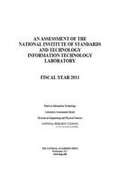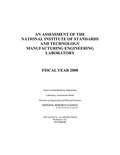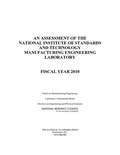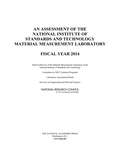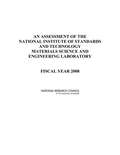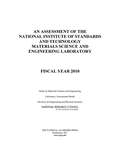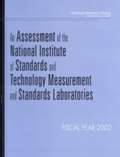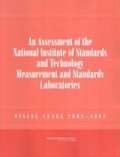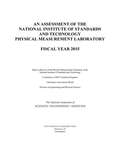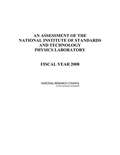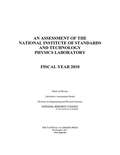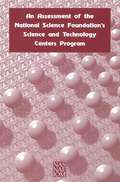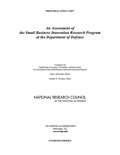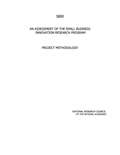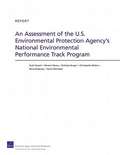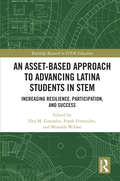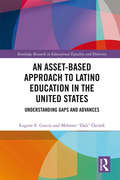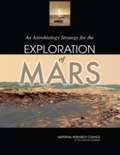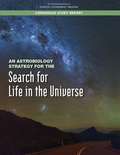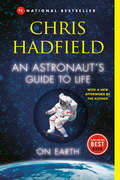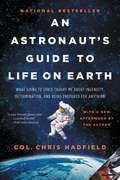- Table View
- List View
An Assessment of the National Institute of Standards and Technology Information Technology Laboratory: Fiscal Year 2011
by Panel on Information TechnologySince 1959, the National Research Council (NRC), at the request of the National Institute of Standards and Technology (NIST), has annually assembled panels of experts to assess the quality and effectiveness of the NIST measurements and standards laboratories. In 2011, the NRC evaluated three of the six NIST laboratories: the Center for Nanoscale Science and Technology (CNST), the NIST Center for Neutron Research (NCNR) and the Information Technology Laboratory (ITL). Each of these was addressed individually by a separate panel of experts; this report assesses ITL.
An Assessment of the National Institute of Standards and Technology Manufacturing Engineering Laboratory
by National Research Council Division on Engineering and Physical Sciences Laboratory Assessments Board Panel on Manufacturing EngineeringThe mission of the Manufacturing Engineering Laboratory (MEL) of the National Institute of Standards and Technology (NIST) is to promote innovation and the competitiveness of U.S. manufacturing through measurement science, measurement services, and critical technical contributions to standards. The MEL is organized in five divisions: Intelligent Systems, Manufacturing Metrology, Manufacturing Systems Integration, Precision Engineering, and Fabrication Technology. A panel of experts appointed by the National Research Council (NRC) assessed the first four divisions. Overall, this book finds that the four individual divisions are performing to the best of their ability, given available resources. In many areas in all four divisions, the capabilities and the work being performed are among the best in the field. However, reduced funding and other factors such as difficulty in hiring permanent staff are limiting (and are likely to increasingly limit) the degree to which MEL programs can achieve their objectives and are threatening the future impact of these programs.
An Assessment of the National Institute of Standards and Technology Manufacturing Engineering Laboratory: Fiscal Year 2010
by National Research Council of the National AcademiesThe mission of the Manufacturing Engineering Laboratory (MEL) of the National Institute of Standards and Technology (NIST) is to promote innovation and the competitiveness of U.S. manufacturing through measurement science, measurement services, and critical technical contributions to standards. The MEL is organized in five divisions: Intelligent Systems, Manufacturing Metrology, Manufacturing Systems Integration, Precision Engineering, and Fabrication Technology. A panel of experts appointed by the National Research Council (NRC) assessed the first four divisions.
An Assessment of the National Institute of Standards and Technology Material Measurement Laboratory: Fiscal Year 2014
by Technology Panel on Review of the Material Measurement Laboratory at the National Institute of StandardsThe National Institute of Standards and Technology's (NIST's) Material Measurement Laboratory (MML) is our nation's reference laboratory for measurements in the chemical, biological, and materials sciences and engineering. Staff of the MML develop state-of-the-art measurement techniques and conduct fundamental research related to measuring the composition, structure, and properties of substances. Tools that include reference materials, data, and measurement services are developed to support industries that range from transportation to biotechnology and to address problems such as climate change, environmental sciences, renewable energy, health care, infrastructure, food safety and nutrition, and forensics. This report assesses the scientific and technical work performed by NIST's Material Measurement Laboratory. In particular, the report assesses the organization's technical programs, the portfolio of scientific expertise within the organization, the adequacy of the organization\'s facilities, equipment, and human resources, and the effectiveness by which the organization disseminates its program outputs.
An Assessment of the National Institute of Standards and Technology Materials Science and Engineering Laboratory
by National Research Council Division on Engineering and Physical Sciences Laboratory Assessments Board Panel on Materials Science and EngineeringThe Materials Science and Engineering Laboratory (MSEL) of the National Institute of Standards and Technology (NIST) works with industry, standards bodies, universities, and other government laboratories to improve the nation's measurements and standards infrastructure for materials. A panel of experts appointed by the National Research Council (NRC) assessed the four divisions of MSEL, by visiting these divisions and reviewing their activities. This book concludes that, for the selected portion of the MSEL programs reviewed, the staff, the projects, and many facilities are outstanding. The projects are clearly focused on the mission of MSEL. The facilities and equipment are rationally upgraded within budget constraints, with several facilities being unique; the funding provided through the America COMPETES Act of 2007 is being used effectively. Division chiefs and staff evinced high morale, attributable to several factors: clear definitions of expectations and of the processes for realizing them, strong support of the MSEL from NIST leadership and of NIST generally from the President and from the Congress (through the American Competitiveness Initiative and the America COMPETES Act), and positive feedback from customers.
An Assessment of the National Institute of Standards and Technology Materials Science and Engineering Laboratory: Fiscal Year 2010
by National Research Council of the National AcademiesThe Materials Science and Engineering Laboratory (MSEL) of the National Institute of Standards and Technology (NIST) works with industry, standards bodies, universities, and other government laboratories to improve the nation's measurements and standards infrastructure for materials. A panel of experts appointed by the National Research Council (NRC) assessed the four divisions of MSEL, by visiting these divisions and reviewing their activities.
An Assessment of the National Institute of Standards and Technology Measurement and Standards Laboratories: FISCAL YEAR 2002
by National Academy of Science the National AcademiesThe National Academies Press (NAP)--publisher for the National Academies--publishes more than 200 books a year offering the most authoritative views, definitive information, and groundbreaking recommendations on a wide range of topics in science, engineering, and health.<P><P> Our books are unique in that they are authored by the nation's leading experts in every scientific field.
An Assessment of the National Institute of Standards and Technology Measurement and Standards Laboratories: FISCAL YEARS 2004 - 2005
by National Research Council of the National AcademiesThe National Institute of Standards and Technology (NIST) Measurements and Standards Laboratories (MSL) provide technical leadership for the nation’s measurement and standards infrastructure and assure the availability of essential reference data and measurement capabilities. <P><P>At NIST’s request the National Research Council (NRC) carries out a biennial assessment of the seven MSL. The assessment focuses on each laboratory’s technical quality and merit; and effectiveness. It also examines the relevance of the NIST programs and how well laboratory facilities, equipment, and personnel are able to fulfill the MSL mission. This report presents an overall assessment of the MSL followed by detailed assessments of each of the seven laboratories.
An Assessment of the National Institute of Standards and Technology Physical Measurement Laboratory: Fiscal Year 2015
by Engineering Medicine National Academies of SciencesThe Physical Measurement Laboratory (PML) at the National Institute of Standards and Technology (NIST) is dedicated to three fundamental and complementary tasks: (1) increase the accuracy of our knowledge of the physical parameters that are the foundation of our technology-driven society; (2) disseminate technologies by which these physical parameters can be accessed in a standardized way by the stakeholders; and (3) conduct research at both fundamental and applied levels to provide knowledge that may eventually lead to advances in measurement approaches and standards. This report assesses the scientific and technical work performed by the PML and identifies salient examples of accomplishments, challenges, and opportunities for improvement for each of its nine divisions.
An Assessment of the National Institute of Standards and Technology Physics Laboratory
by National Research Council Division on Engineering and Physical Sciences Laboratory Assessments Board Panel On PhysicsThe mission of the NIST Physics Laboratory is to support U.S. industry, government, and the scientific community by providing measurement services and research for electronic, optical, and radiation technology. In this respect, the laboratory provides the foundation for the metrology of optical and ionizing radiations, time and frequency, and fundamental quantum processes, historically major areas of standards and technology. The Panel on Physics visited the six divisions of the laboratory and reviewed a selected sample of their programs and projects. This book finds that the overall quality and productivity of the Physics Laboratory are comparable to or better than those of other peer institutions, an accomplishment that is being achieved with an infrastructure that is smaller in both size and funding than the size and funding of most national and agency laboratories in the United States.
An Assessment of the National Institute of Standards and Technology Physics Laboratory: Fiscal Year 2010
by National Research Council of the National AcademiesThe mission of the National Institute of Standards and Technology (NIST) Physics Laboratory is to support U.S. industry, government, and the scientific community by providing measurement services and research for electronic, optical, and radiation technology. In this respect, the laboratory provides the foundation for the metrology of optical and ionizing radiations, time and frequency, and fundamental quantum processes, historically major areas of standards and technology. The Panel on Physics visited the six divisions of the laboratory and reviewed a selected sample of their programs and projects.
An Assessment of the National Science Foundation's Science and Technology Centers Program
by Committee on Science Engineering Public PolicyAn Assessment of the National Science Foundation's Science and Technology Centers Program
An Assessment of the Need for Native Seeds and the Capacity for Their Supply: Interim Report
by Committee on National Statistics Board on Agriculture and Natural Resources Division of Behavioral and Social Sciences and Education Division on Earth and Life Studies National Academies of Sciences, Engineering, and Medicine Committee on an Assessment of Native Seed Needs and CapacitiesAcross the United States, millions of acres of land have been so disturbed by human activities or severe climate events that significant portions of their native plant communities have been lost and their ecosystems have been seriously compromised. Restoring impaired ecosystems requires a supply of diverse native plant seeds that are well suited to the climates, soils, and other living species of the system. Native seeds are also in demand for applications in urban land management, roadside maintenance, conservation agriculture, and other restorative activities that take into account the connection between native plant communities and the increasingly urgent need for resilient landscapes. Given the varied climatic and environmental niches of the more than 17,000 native plant species of the United States, supplying the desired seed types and species mixes for this wide range of activities is a challenge. As the first phase of a nationwide analysis of the full scope of needs for native plant seeds, this interim report describes the participants in the native plant seed supply chain, makes preliminary observations, and proposes an information-gathering plan for the second phase of the assessment.
An Assessment of the Prospects for Inertial Fusion Energy
by National Research Council Division on Engineering and Physical Sciences Board on Physics and Astronomy Board on Energy and Environmental Systems Committee on the Prospects for Inertial Confinement Fusion Energy SystemsThe potential for using fusion energy to produce commercial electric power was first explored in the 1950s. Harnessing fusion energy offers the prospect of a nearly carbon-free energy source with a virtually unlimited supply of fuel. Unlike nuclear fission plants, appropriately designed fusion power plants would not produce the large amounts of high-level nuclear waste that requires long-term disposal. Due to these prospects, many nations have initiated research and development (R&D) programs aimed at developing fusion as an energy source. Two R&D approaches are being explored: magnetic fusion energy (MFE) and inertial fusion energy (IFE). An Assessment of the Prospects for Inertial Fusion Energy describes and assesses the current status of IFE research in the United States; compares the various technical approaches to IFE; and identifies the scientific and engineering challenges associated with developing inertial confinement fusion (ICF) in particular as an energy source. It also provides guidance on an R&D roadmap at the conceptual level for a national program focusing on the design and construction of an inertial fusion energy demonstration plant.
An Assessment of the SBIR Program at the Department of Defense
by National Research Council of the National AcademiesThe SBIR program allocates 2.5 percent of 11 federal agencies' extramural R&D budgets to fund R&D projects by small businesses, providing approximately $2 billion annually in competitive awards. At the request of Congress, the National Academies conducted a comprehensive study of how the SBIR program has stimulated technological innovation and used small businesses to meet federal research and development needs. Drawing substantially on new data collection, this book examines the SBIR program at the Department of Defense and makes recommendations for improvements. Separate reports will assess the SBIR program at NSF, NIH, DOE, and NASA, respectively, along with a comprehensive report on the entire program.
An Assessment of the Science Proposed for the Deep Underground Science and Engineering Laboratory(DUSEL)
by Ad Hoc Committee to Assess the Science Proposed for a Deep Underground Science Engineering LaboratoryAccording to the big bang theory, our Universe began in a state of unimaginably high energy and density, contained in a space of subatomic dimensions. At that time, unlike today, the fundamental forces of nature were presumably unified and the particles present were interacting at energies not attainable by present-day accelerators. Underground laboratories provide the conditions to investigate processes involving rare phenomena in matter and to detect the weak effects of highly elusive particles by replicating similar environments to those once harnessed during the earliest states of the Earth. These laboratories now appear to be the gateway to understanding the physics of the grand unification of the forces of nature. Built to shield extremely sensitive detectors from the noise of their surroundings and the signals associated with cosmic rays, underground facilities have been established during the last 30 years at a number of sites worldwide. To date, the United States' efforts to develop such facilities have been modest and consist primarily of small underground laboratories. However, the U. S. underground community has pushed for larger underground facilities on the scale of major laboratories in other countries. An Assessment of the Deep Underground Science and Engineering Laboratory (DUSEL) addresses this matter by evaluating the major physics questions and experiments that could be explored with the proposed DUSEL. Measuring the potential impact, this assessment also examines the broader effects of the DUSEL in regards to education and public outreach, and evaluates the need associated with developing U. S. programs similar to science programs in other regions of the world.
An Assessment of the Small Business Innovation Research Program: Project Methodology
by Technology Committee on Capitalizing on Science Innovation: An Assessment of the Small Business Innovation Research ProgramIn response to a Congressional mandate, the National Research Council conducted a review of the SBIR program at the five federal agencies with SBIR programs with budgets in excess of $100 million (DOD, NIH, NASA, DOE, and NSF). The project was designed to answer questions of program operation and effectiveness, including the quality of the research projects being conducted under the SBIR program, the commercialization of the research, and the program's contribution to accomplishing agency missions. This report describes the proposed methodology for the project, identifying how the following tasks will be carried out: 1) collecting and analyzing agency databases and studies; 2) surveying firms and agencies; 3) conducting case studies organized around a common template; and 4) reviewing and analyzing survey and case study results and program accomplishments. Given the heterogeneity of goals and procedures across the five agencies involved, a broad spectrum of evaluative approaches is recommended.
An Assessment of the U.S. Environmental Protection Agency's National Environmental Performance Track Program
by Rena Rudavsky Noreen Clancy Nicholas Burger Christopher Nelson Scott HassellThis report addresses the conceptual basis, design, and implementation of the National Environmental Performance Track program. The voluntary program sought to encourage facilities to improve their environmental performance and provide a more collaborative relationship between facilities and regulators. While the program had mixed success, EPA should continue to seek out new approaches to complement and enhance traditional regulatory approaches.
An Asset-Based Approach to Advancing Latina Students in STEM: Increasing Resilience, Participation, and Success (Routledge Research in STEM Education)
by Frank Fernandez Elsa M. Gonzalez Miranda WilsonThis timely volume challenges the ongoing underrepresentation of Latina women in science, technology, engineering and mathematics (STEM), and highlights resilience as a critical communal response to increasing their representation in degree programs and academic posts. An Asset-Based Approach to Advancing Latina Students in STEM documents the racialized and gendered experiences of Latinas studying and researching in STEM in US colleges, and centers resilience as a critical mechanism in combating deficit narratives. Adopting an asset-based approach, chapters illustrate how Latinas draw on their cultural background as a source of individual and communal strength, and indicate how this cultural wealth must be nurtured and used to inform leadership and policy to motivate, encourage, and support Latinas on the pathway to graduate degrees and successful STEM careers. By highlighting strategies to increase personal resilience and institutional retention of Latina women, the text offers key insights to bolstering diversity in STEM. This text will primarily appeal to academics, scholars, educators, and researchers in the fields of STEM education. It will also benefit those working in broader areas of higher education and multicultural education, as well as those interested in the advancement of minorities inside and outside of academia. Elsa M. Gonzalez is Assistant Professor of Higher Education at the University of Houston, USA. Frank Fernandez is Assistant Professor of Higher Education at the University of Mississippi, USA. Miranda Wilson earned a Ph.D. in Higher Education Leadership and Policy Studies at the University of Houston, USA.
An Asset-Based Approach to Latino Education in the United States: Understanding Gaps and Advances (Routledge Research in Educational Equality and Diversity)
by Eugene E. Garcia Mehmet OzturkChallenging perspectives that often characterize Latinos as ‘at-risk,’ this book takes an ‘asset’ approach, highlighting the favorable linguistic, cognitive, education, and cultural assets Latino children bring to educational settings. An Asset-Based Approach to Latino Education in the United States addresses the increasingly important challenge and opportunity of educating the linguistic and cultural diversity of the growing population of Latino students. The book confronts the educational debate regarding effective instructional practices for Latinos, bilingual education, immigration, and assimilation.
An Astrobiology Strategy for the EXPLORATION of MARS
by National Research Council of the National AcademiesThree recent developments have greatly increased interest in the search for life on Mars. The first is new information about the Martian environment including evidence of a watery past and the possibility of atmospheric methane. The second is the possibility of microbial viability on Mars. Finally, the Vision for Space Exploration initiative included an explicit directive to search for the evidence of life on Mars. These scientific and political developments led NASA to request the NRC’s assistance in formulating an up-to-date integrated astrobiology strategy for Mars exploration. Among other topics, this report presents a review of current knowledge about possible life on Mars; an astrobiological assessment of current Mars missions; a review of Mars-mission planetary protection; and findings and recommendations. The report notes that the greatest increase in understanding of Mars will come from the collection and return to Earth of a well-chosen suite of Martian surface materials.
An Astrobiology Strategy for the Search for Life in the Universe
by Engineering Medicine National Academies of SciencesAstrobiology is the study of the origin, evolution, distribution, and future of life in the universe. It is an inherently interdisciplinary field that encompasses astronomy, biology, geology, heliophysics, and planetary science, including complementary laboratory activities and field studies conducted in a wide range of terrestrial environments. Combining inherent scientific interest and public appeal, the search for life in the solar system and beyond provides a scientific rationale for many current and future activities carried out by the National Aeronautics and Science Administration (NASA) and other national and international agencies and organizations. Requested by NASA, this study offers a science strategy for astrobiology that outlines key scientific questions, identifies the most promising research in the field, and indicates the extent to which the mission priorities in existing decadal surveys address the search for life’s origin, evolution, distribution, and future in the universe. This report makes recommendations for advancing the research, obtaining the measurements, and realizing NASA’s goal to search for signs of life in the universe.
An Astronaut's Guide to Life on Earth
by Chris HadfieldAs Commander of the International Space Station, Chris Hadfield captivated the world with stunning photos and commentary from space. Now, in his first book, Chris offers readers extraordinary stories from his life as an astronaut, and shows how to make the impossible a reality. Chris Hadfield decided to become an astronaut after watching the Apollo moon landing with his family on Stag Island, Ontario, when he was nine years old, and it was impossible for Canadians to be astronauts. In 2013, he served as Commander of the International Space Station orbiting the Earth during a five-month mission. Fulfilling this lifelong dream required intense focus, natural ability and a singular commitment to "thinking like an astronaut." In An Astronaut's Guide to Life on Earth, Chris gives us a rare insider's perspective on just what that kind of thinking involves, and how earthbound humans can use it to achieve success and happiness in their lives.Astronaut training turns popular wisdom about how to be successful on its head. Instead of visualizing victory, astronauts prepare for the worst; always sweat the small stuff; and do care what others think. Chris shows how this unique education comes into play with dramatic anecdotes about going blind during a spacewalk, getting rid of a live snake while piloting a plane, and docking with space station Mir when laser tracking systems fail at the critical moment. Along the way, he shares exhilarating experiences, and challenges, from his 144 days on the ISS, and provides an unforgettable answer to his most-asked question: What's it really like in outer space?Written with humour, humility and a profound optimism for the future of space exploration, An Astronaut's Guide to Life on Earth offers readers not just the inspiring story of one man's journey to the ISS, but the opportunity to step into his space-boots and think like an astronaut--and renew their commitment to pursuing their own dreams, big or small.
An Astronaut's Guide to Life on Earth: What Going To Space Taught Me About Ingenuity, Determination, And Being Prepared For Anything
by Chris HadfieldAs Commander of the International Space Station, Chris Hadfield captivated the world with stunning photos and commentary from space. Now, in his first book, Chris offers readers extraordinary stories from his life as an astronaut, and shows how to make the impossible a reality. Chris Hadfield decided to become an astronaut after watching the Apollo moon landing with his family on Stag Island, Ontario, when he was nine years old, and it was impossible for Canadians to be astronauts. In 2013, he served as Commander of the International Space Station orbiting the Earth during a five-month mission. Fulfilling this lifelong dream required intense focus, natural ability and a singular commitment to &“thinking like an astronaut.&” In An Astronaut&’s Guide to Life on Earth, Chris gives us a rare insider&’s perspective on just what that kind of thinking involves, and how earthbound humans can use it to achieve success and happiness in their lives.Astronaut training turns popular wisdom about how to be successful on its head. Instead of visualizing victory, astronauts prepare for the worst; always sweat the small stuff; and do care what others think. Chris shows how this unique education comes into play with dramatic anecdotes about going blind during a spacewalk, getting rid of a live snake while piloting a plane, and docking with space station Mir when laser tracking systems fail at the critical moment. Along the way, he shares exhilarating experiences, and challenges, from his 144 days on the ISS, and provides an unforgettable answer to his most-asked question: What&’s it really like in outer space?Written with humour, humility and a profound optimism for the future of space exploration, An Astronaut&’s Guide to Life on Earth offers readers not just the inspiring story of one man&’s journey to the ISS, but the opportunity to step into his space-boots and think like an astronaut—and renew their commitment to pursuing their own dreams, big or small.
An Astronaut's Guide to Life on Earth: What Going to Space Taught Me About Ingenuity, Determination, and Being Prepared for Anything
by Chris HadfieldColonel Chris Hadfield has spent decades training as an astronaut and has logged nearly 4000 hours in space. During this time he has broken into a Space Station with a Swiss army knife, disposed of a live snake while piloting a plane, and been temporarily blinded while clinging to the exterior of an orbiting spacecraft. The secret to Col. Hadfield's success-and survival-is an unconventional philosophy he learned at NASA: prepare for the worst-and enjoy every moment of it. In An Astronaut's Guide to Life on Earth, Col. Hadfield takes readers deep into his years of training and space exploration to show how to make the impossible possible. Through eye-opening, entertaining stories filled with the adrenaline of launch, the mesmerizing wonder of spacewalks, and the measured, calm responses mandated by crises, he explains how conventional wisdom can get in the way of achievement-and happiness. His own extraordinary education in space has taught him some counterintuitive lessons: don't visualize success, do care what others think, and always sweat the small stuff. You might never be able to build a robot, pilot a spacecraft, make a music video or perform basic surgery in zero gravity like Col. Hadfield. But his vivid and refreshing insights will teach you how to think like an astronaut, and will change, completely, the way you view life on Earth-especially your own.
